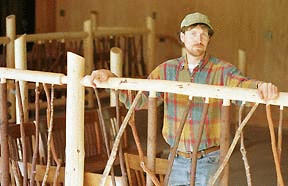Technology is balanced by the human touch at Puget Sound Environmental Learning Center.
Hand-made furniture and architectural detailing by craftspersons like woodworker David Kotz bring a warmth and intimacy to the buildings that are often tall and angled to accommodate the exterior solar panels.
Kotz’s every-which-way railings attract the eye straightaway in the dining hall.
“They were hard to do,” Kotz said. “The more wild the piece is, the harder it is to make.”
Kotz came to PSELC at the invitation of founder Debbie Brainerd.
When it came to crafting the look of the new center for environmental stewardship, Brainerd, who had studied art in college, looked to artists’ input.
“Debbie had a lot of meetings for artists,” Kotz said. “I went to several of them. I heard they might need some craftspersons to make things. I kept my foot in the door.”
Brainerd spent two years in focus groups with various local constituencies to find out what was important to the local people.
You couldn’t get much more local than Kotz.
Born on Bainbridge, Kotz is raising his family on two-and-a half of the 10 acres off Mandus Olson Road where he grew up.
“My Dad was an architect who came to Puget Sound to work on the World’s Fair in 1962,” Kotz said. “I’ve spent my whole life here and now we live in a house on the site of the house I grew up in, and my brother has the land that adjoins ours.
“This is my little refuge.”
Although Kotz had made his living
doing residential work, he notes that he had never worked with a contractors as large as those at PSELC.
“I had to get bonded and I had to get $1 million dollars worth of insurance just to get on the site.
Kotz says he worked as a subcontractor for an hourly wage.
“I didn’t have any idea what to ask for,” Kotz said. “I made out OK.”
To make the nine eight-foot by three-foot railings that ring the sunken dining area, Kotz used wood cut on his property from cherry and hazelnut trees and from blueberry bushes.
“All “food woods,’” Kotz said, “plus some madrona.”
Kotz cut nearly all the wood from his property, kiln-dried them and then stored them in his heated storage shed.
In stead of running vertical slats between the top and bottom hortizontals of the railings, Kotz, who has no formal training in carpentry, used branches that make a pleasingly erratic, pattern that resembles a child’s line drawing – if that child were blindfolded.
Adirondack -style is bark-on,” Kotz said. “I like bark-off. I like the shape of the wood under the bark, and the texture.“
For his railing project, Kotz used some of each.
He “tenon-cut” the bottoms of the sticks, drilled a hole in the bottom horizontal, and placed the stick.
Then came the really tricky part, Kotz says.
He would see where the top wanted to go, where it ‘hit’ the horizontal, cut the stick to length, tenon it, visually assess the angle and drill a hole.
“It was tough, because it was a compound angle,” Kotz said. “The good thing was, they were all fairly flexible sticks.”
The lovingly crafted creation that grew out of scrap wood “recycled” from Kotz’s fruit tree prunings is emblematic of Brainerd’s grand scheme to combine the arts, science and technology to teach earth stewardship.



